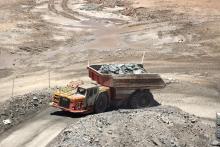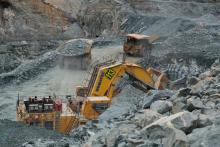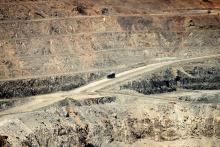The owner of Kalgoorlie’s famous Super Pit says there are decades of activity to come.


“Like a kid in a candy shop” is how a company geologist described exploring the Golden Mile deposit during a recent tour of the asset located on the outskirts of Kalgoorlie.
The rich deposit has underpinned near-continuous production since it was discovered in 1893, having delivered 65 million ounces since then.
Now, the chief executive of Northern Star Resources, which, through its Kalgoorlie Consolidated Gold Mines subsidiary, owns the Super Pit, says there may be more gold to come out of the ground than has been mined already.
Stuart Tonkin says, contrary to speculation, the miner has decades of pit activity ahead.
“In parallel to that we’ll build large-scale and multiple undergrounds along this Golden Mile,” Mr Tonkin told media, investors and analysts on a mine tour the day before the recent Diggers and Dealers Mining Forum.
“My attitude is that if the geology continues, if you get the costs right and if the minerals are there … then there’s a lot of life to come out of it.
“And you obviously see the quality of the team doing great work. That’s going to underpin the future.
“I’m talking decades, and it has a century of history. My attitude is there’s almost more gold in the ground than has come out already.
“I’m really confident in the outlook of KCGM.”
Northern Star has three production centres: the Kalgoorlie hub that includes KCGM, Yandal in the northern Goldfields, and Pogo in Alaska.
KCGM comprises the Fimiston open pit (Super Pit), the Fimiston and Mt Charlotte underground assets and two processing plants, named Fimiston and Gidji.
Since acquiring 100 per cent of KCGM through the merger with Saracen, Northern Star has upped its ore reserve by 36 per cent to 13 million ounces, supporting a mine life of 20 years.
Northern Star is developing its KCGM underground assets. Photo: Isabel Vieira
Underground
Northern Star is ramping up development of its Mt Charlotte underground mine while further developing its Fimiston underground assets, with up to four portals planned this financial year.
At Fimiston, the company is targeting three mining areas: United Consols, Union Jack and Golden Pike Stockworks, alongside its Croesus early stage asset.
The state’s largest gold producer by ounces, according to Data & Insights, Northern Star has described the three areas as essentially three mines within one.
Fimiston underground has an ore reserve of 800,000 ounces, which Northern Star said demonstrated huge underground potential at KCGM.
The goldminer also has a number of what it calls “strategic regional opportunities” for KCGM. Its Hercules discovery in 2023 was singled out at the mine site visit.
The early stage discovery still needs to be defined, but Northern Star said the asset was poised to become a mine as soon as capital could be deployed.
Northern Star’s ore reserve includes a 3.1 million ounce stock pile it dubbed the “insurance policy” behind its $1.5 billion mill expansion, now in its second year of construction.
According to the miner, there’s $6 billion worth of margin in the ore stockpile at the current gold price, which is sitting around $3,700 per ounce.
The mill expansion is expected to take the Fimiston processing plant’s capacity from 13 million tonnes per annum to 27mtpa by financial year 2029 to lift KCGM’s production to 900,000 ounces per annum.
By then, the Gidji processing plant will be retired.
Northern Star said it spent $348 million, or 23 per cent of the capital cost, on the mill expansion in the 2024 financial year. About 81 per cent of the total project budget has been committed.
So far, early works have been completed and initial construction infrastructure is in place, with the additional workforce onsite. KCGM employs 890 staff in total.
The KCGM operation produced 437,000 ounces in FY24, down from previous years. It plans to ramp up to 650,000 ounces a year by FY26, on its way to 900,000 ounces before the decade’s end.
For context, record production for KCGM was 936,800 ounces in 2004.
Speaking on the ambitious production target, Mr Tonkin said the company would move pretty quickly past that historic record to deliver 900,000 ounces.
He said there were also opportunities with the regional discoveries, like Hercules, to potentially build on that growth target.
“I think it’s going to hold its title as the top five global goldmine and one of Australia’s largest for a long time,” Mr Tonkin said.
Portfolio
Mr Tonkin ruled out accumulating additional ounces by acquiring nearby junior miners, instead reiterating his focus on growing the company’s existing portfolio.
“We don’t have the need,” he said.
“We have enough in front of us in our own organic portfolio that we’re advancing, and that’s where our focus is at the moment.”
Further, Mr Tonkin said now would be the time to sell, not buy, but that the goldminer was not motivated to do either, again pointing to its growth pipeline.
“You’re right saying the gold price is where it is, potentially this is the time to sell goldmines, not buy them. That would be the rhetoric,” Mr Tonkin said.
“Our attitude is [that] everything we have is for a purpose and a reason, and it’s delivering into our strategy. So, we’re not motivated to do either, buy or sell.
“We have a very solid, organic pathway with great returns, and that’s what we’re focused on.”
Mr Tonkin said he was starting to see some costs stabilise and labour pressures ease as commodity prices came off, such as those for nickel and lithium.
In the wake of BHP mothballing its Nickel West operations from October, Northern Star had been in conversations about bringing onboard some of those workers.
BHP moved to suspend its Nickel West operations until at least 2027, affecting 3,000 staff at its Goldfields operations and Kwinana Nickel Refinery.
“Nickel West has been very proactive in engaging other businesses in the Goldfields and those forums have been held here,” Mr Tonkin said.
“I think that’s very important to keep those skills here in the Goldfields. They’ve got families in Kalgoorlie, they’ve got kids in school. It’s really key that we can try and pin some of the Nickel West employees here.
“But we’ve also reached out to other companies on the journey and offered support and we’ve always promoted gold as a great place to be.”

The fallout from BHP’s decision spread widely, with one factor being the sulphuric acid production bought by the likes of Lynas Rare Earths.
Now that the supply tap had been turned off, Mr Tonkin said he understood there was a need in town and that his company had the capacity to consider filling some of the gap.
“It’s about being a good neighbour. We’re here and if there’s something we can do to help other businesses locally, we will absolutely consider that and evaluate it,” he said.
“We cannot generate the volumes coming off that local supply, but we certainly could contribute to the solution.”
To achieve full potential at the Super Pit, the goldminer needs to complete the costly East Wall remediation works after the geotechnical failure in 2018.
Its mined 30mtpa since the huge slip, with the remaining 2mtpa to be moved early this financial year before it can reach “the honey at the bottom of the pot”.
The last leg of the work isn’t without its challenges, however, with some sizeable rocks needing to be blasted and moved before that gold can be accessed.













